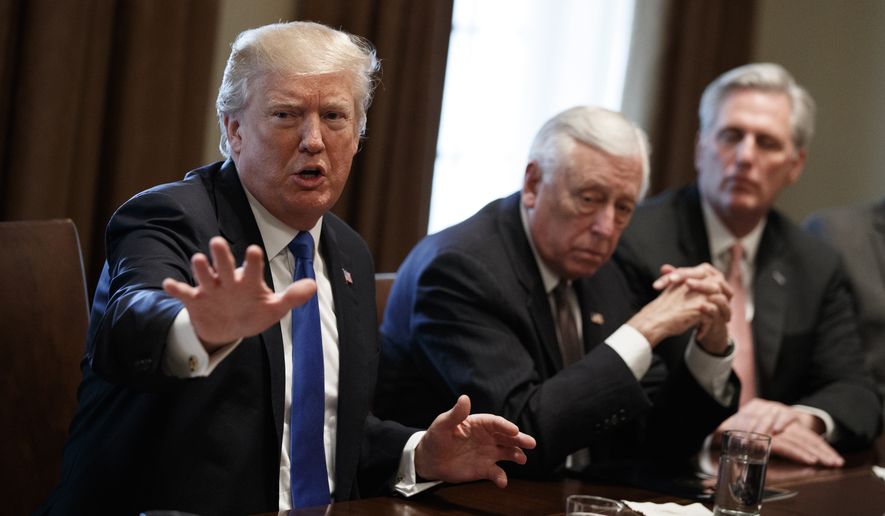Rarely has a president granted the media such access to a high-level meeting inside the White House.
As President Trump met with senior congressional Republicans and Democrats on immigration Tuesday, his aides unexpectedly allowed journalists to record the lengthy discussion in the Cabinet room, with both sides airing their views and negotiating openly while cameras rolled. And rolled. And rolled.
Ordinarily, in recent administrations, the press “pool” is invited in at the beginning of such meetings to hear an innocuous opening statement from the president and perhaps to ask a few questions. Typically, journalists are ushered out after only a few minutes.
On Tuesday, a gregarious Mr. Trump kept the press in the room for 55 minutes as he held court.
He invited nearly everyone at the table to have their say. He urged bipartisan cooperation, promising to sign whatever bill Congress brings him. He dangled the prospect of “comprehensive” immigration reform in the near future, despite the well-known opposition from the far right and far left.
“If you want to take it that further step, I’ll take the heat,” the president said. “I’ll take the heat off of both the Democrats and the Republicans. My whole life has been heat. I like heat, in a certain way.”
SEE ALSO: Donald Trump makes progress on DACA deal, border security remains sticking point
He even encouraged lawmakers to bring back “earmarks,” the banned spending on lawmakers’ pet projects that greased many costly deals of the past, as a way to promote compromise. He joked, listened, accepted flattery, told anecdotes and presided over a positive tone on an issue that has eluded a legislative solution for a decade or more.
“Normally, you wouldn’t have a president coming to this meeting,” Mr. Trump told the lawmakers. “Normally, frankly, you’d have Democrats and Republicans, and nothing would get done. Our system lends itself to not getting things done.”
He lamented the bitter partisanship in Washington and cajoled two lawmakers of opposing parties, “Why don’t you guys go out to dinner together?”
House Minority Whip Steny Hoyer of Maryland, seated next to the president, quipped, “We can usually get bipartisan agreement when the other guy buys.”
Eventually, the press was kicked out, but not before the president took a few questions from reporters, which prompted even more discussions about immigration in front of the TV cameras.
“The press is still here,” Mr. Hoyer muttered at one point.
SEE ALSO: Donald Trump calls GOP Dreamer fix a ‘bill of love,’ seeks deal with Dems on immigration
Viewers could almost see the calculations taking place at the table. While many lawmakers believe press coverage inhibits frank talk, it also provided an opportunity to trap the opposition into an unwanted position on camera.
Sen. Dianne Feinstein, California Democrat, asked Mr. Trump at one point to consider a “clean” bill on amnesty for young illegal immigrants, and the president said he had “no problem with that,” although he added that “I think we have to do DACA [the amnesty program] first.” House Majority Leader Kevin McCarthy, California Republican, jumped into clarify that “clean” meant a bill including border security measures.
White House press secretary Sarah Huckabee Sanders said the president, who is under attack from critics as disengaged and erratic, was “showing his leadership” on immigration.
“A number of individuals in the room felt it was a good thing to let you see the cooperation and the conversation between both sides, and see how we’re working and leading to move the ball down the field and come up with some real solutions,” she told reporters.
Some lawmakers remarked on the unprecedented spectacle of the media watching a relatively free-flowing discussion that ordinarily would have taken place behind closed doors.
Sen. Lindsey Graham, South Carolina Republican, called it the “most fascinating meeting I’ve been involved with in 20 plus years in politics.”
Sen. Charles E. Schumer, who has repeatedly blasted the president for tweeting, saying it undermined his leadership, saw Tuesday’s meeting as a positive step.
“I was encouraged by the tone,” the New York Democrat said.
Republican strategist Ana Navarro tweeted, “This bipartisan immigration meeting, and Trump’s interactions in it, all of it is quite extraordinary.”
Conservative commentator S.E. Cupp said, “That meeting was remarkable. Trump should do that every damn day.”
Such extensive media coverage of bipartisan negotiations with the White House is unusual but not unprecedented. In February 2010, President Obama hosted lawmakers of both parties at Blair House for talks on health care, much of which was televised, including some testy exchanges.
For example, Mr. Obama called out Rep. Eric Cantor, Virginia Republican, for bringing “props” to the meeting (he had a large stack of papers with him). The president also chided Republican Sen. John McCain of Arizona, his vanquished rival in the 2008 election, saying at one point, “We’re not campaigning anymore. The election is over.”
Mr. McCain replied, “I’m reminded of that every day.”
And at the beginning of Mr. Trump’s presidency, he often allowed reporters to stay in meetings and events for 30 minutes or more, which journalists at the time greeted as a pleasant departure from the usually brief media events of the Obama White House.
But as Mr. Trump’s first year in office concluded, his relationship with the press had mostly soured, stoked by relentless coverage of what he describes as the “fake news hoax” of the special counsel’s investigation into possible Russian collusion with his campaign.
In fact, Mr. Trump plans to hold a mocking “fake news awards” ceremony on Wednesday to slam some of his least favorite media figures. The scorn has intensified in recent days with the saturated coverage of Michael Wolff’s book “Fire and Fury: Inside the Trump White House,” a disparaging and unflattering look at the West Wing, the president and his family.
And while the media and other pundits expressed giddy surprise at the high level of access to the president’s big meeting Tuesday, Mrs. Sanders brought reporters back down to earth after it had ended.
Noting the tentative outline of topics that was agreed on by participants in the Cabinet room, Mrs. Sanders told journalists: “The deal didn’t take place until after you guys left.”
• Dave Boyer can be reached at dboyer@washingtontimes.com.




Please read our comment policy before commenting.